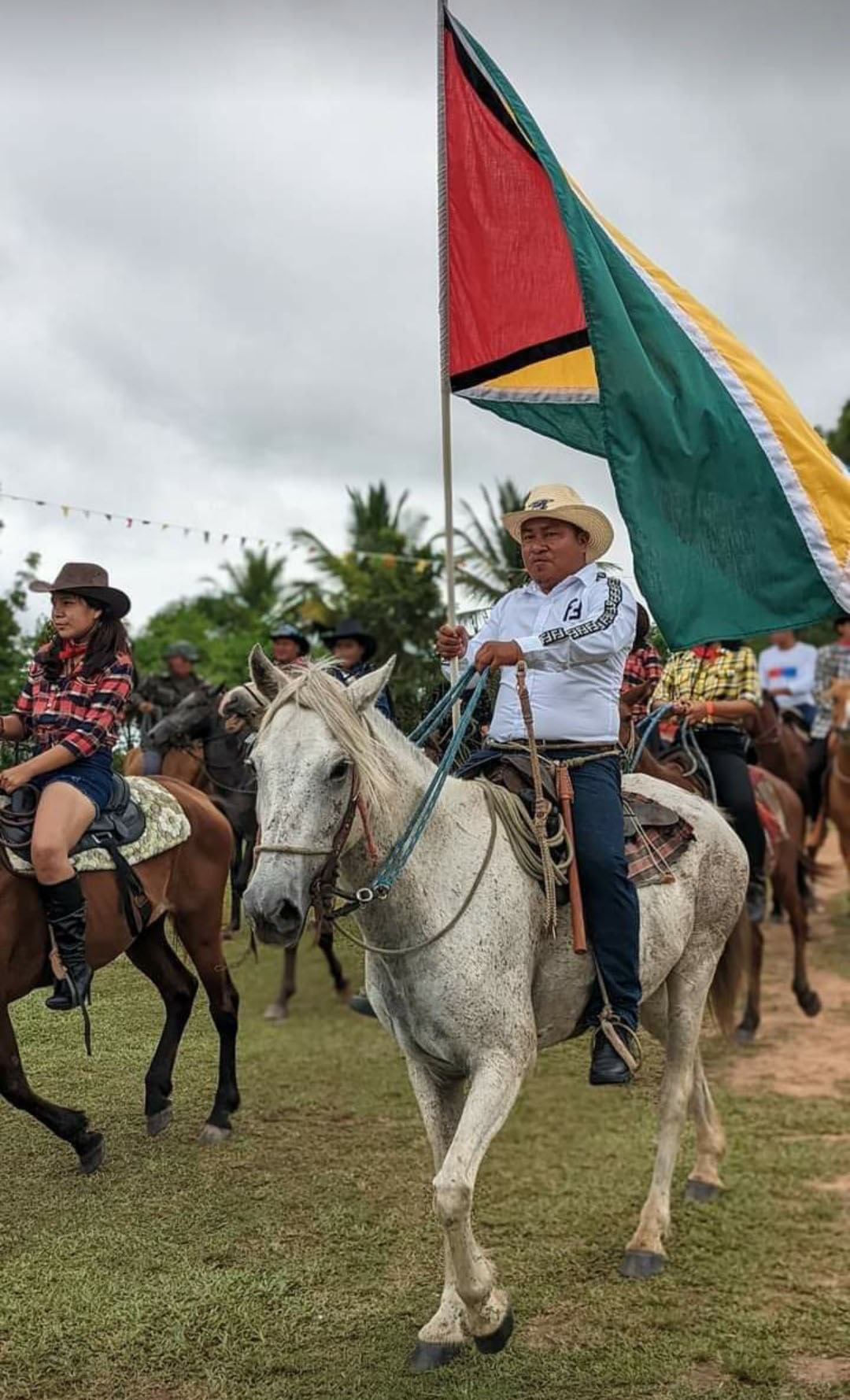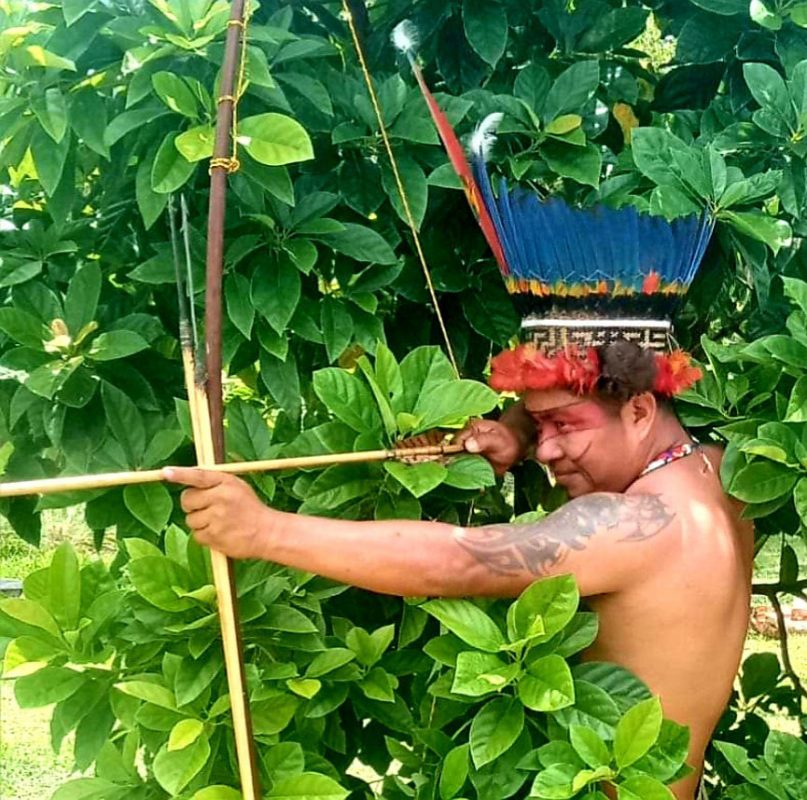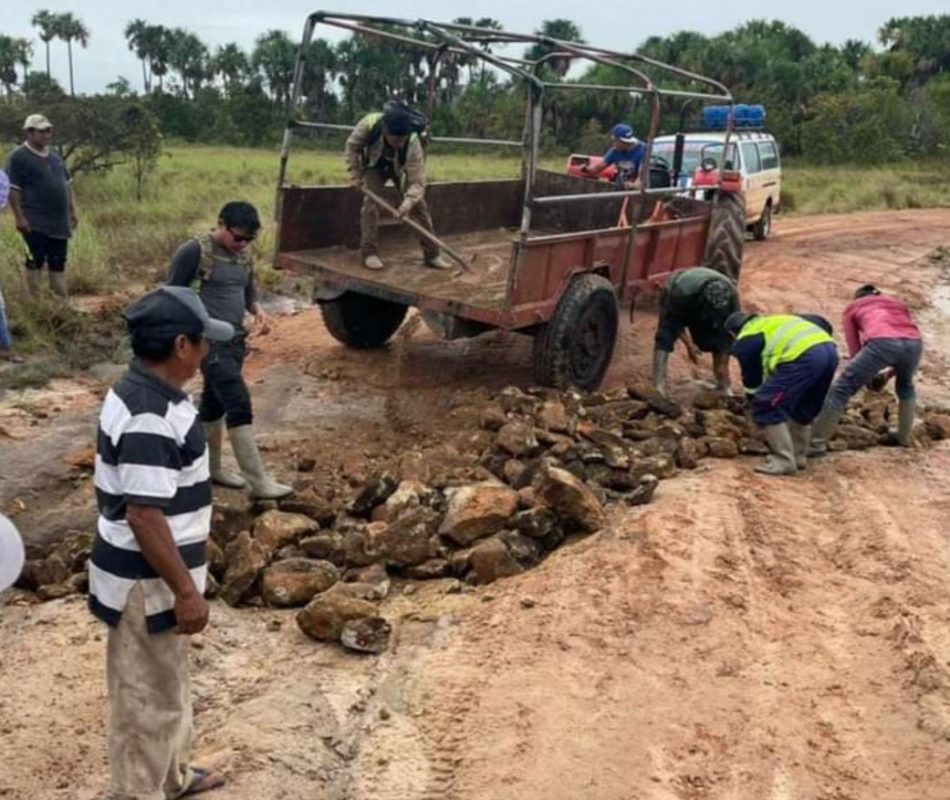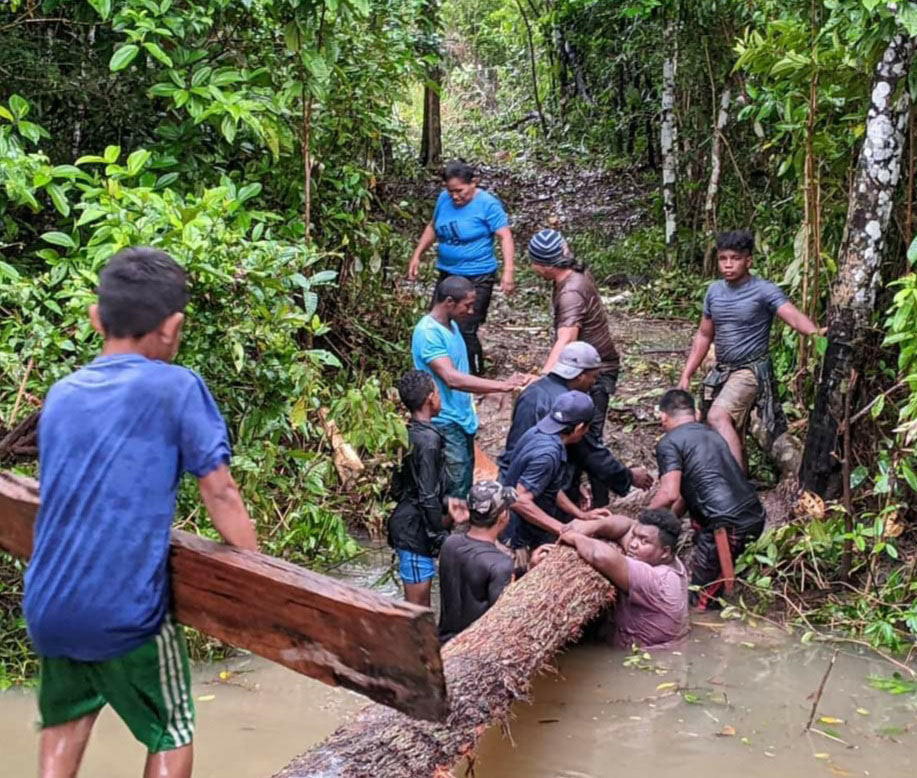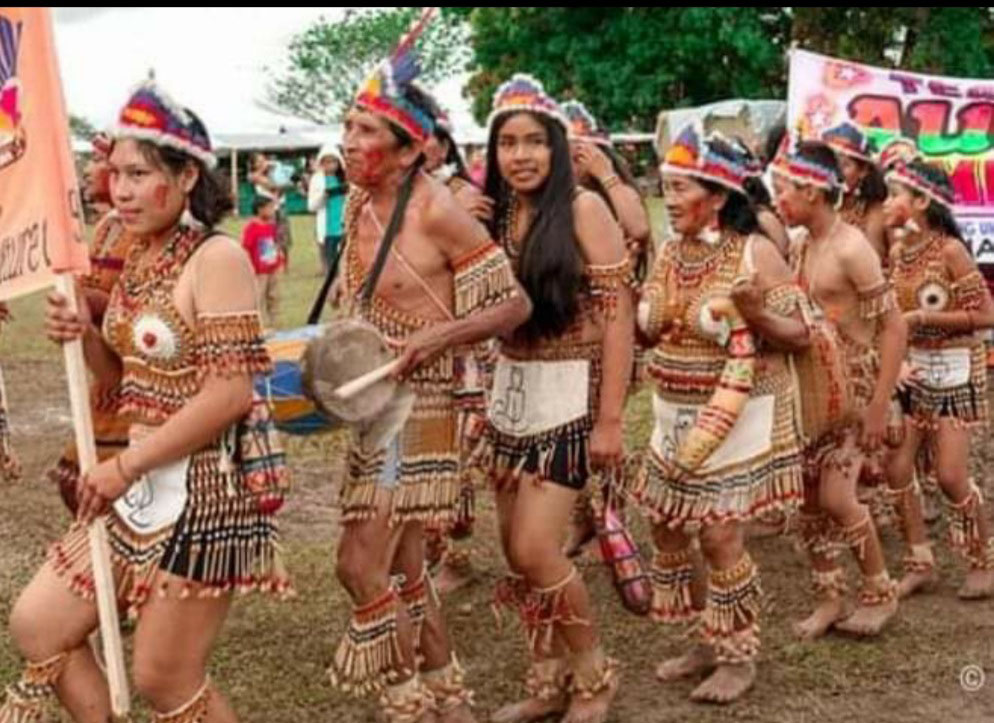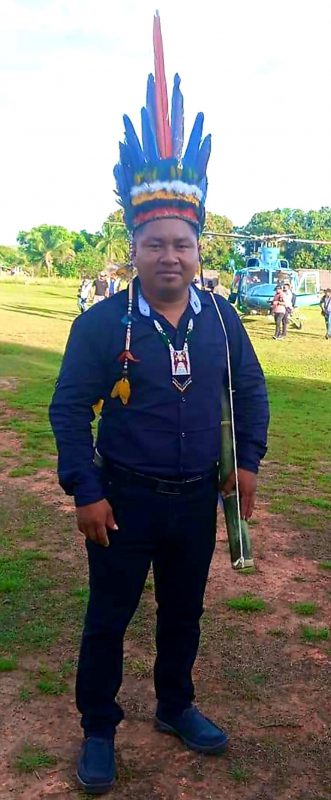Michael Thomas, 35, Indigenous People’s activist, guitarist and dancer, is the toshao of Aishalton Village in the South Rupununi, chairman of the South Rupununi Development Council (SRDC) and an executive member of the National Toshaos Council (NTC), things he never dreamed of becoming.
“My early childhood days or my family background didn’t reflect anything about who I am today. My parents were never leaders in my village. But growing up and in school, I was always the top student, especially in my secondary school life. I was also elected head prefect at Aishalton Secondary.”
Thomas was among the first batch of students to walk the corridors of Aishalton Secondary School in 2009 but was transferred two years later to St Ignatius Secondary School in Lethem, Central Rupununi, where he lived with guardians. At St Ignatius, he wrote the Caribbean Secondary Education Certificate examinations in 2014 and graduated as the school’s top student. He then went on to the University of Guyana, where he obtained a diploma in computer science on a partial Public Service Ministry scholarship which provided for tuition only. His parents met his financial needs for boarding, lodging and acquisition of learning materials. Thomas is the fourth of five siblings.
On his return to the Rupununi, he was employed as a district development officer (DDO) from 2012 to 2014 by the Regional Democratic Council of Region 9 – Upper Essequibo/Upper Takutu.
“As a DDO, I was tasked to work closely with toshaos, other village leaders and generally with village councils. It was as a DDO that I learnt most of my administrative skills, being involved in different programmes and activities. You can say I had to learn on the job as well. That’s where everyone saw my interest in village affairs and community development. I gained a lot of experience from visiting the villages in the sub districts, gathering information on village issues, tabling these issues at the level of the RDC and guiding and directing [the] village council on possible ways in which they could address the issues. I also had responsibility for government assets across the South Rupununi district.”
Thomas assisted villages in organising a variety of different social and socio-economic activities to benefit the communities, including ministerial outreaches.
His responsibilities as DDO, he said, were similar to those of a toshao. On issues of compensation for the work toshaos have to undertake in their communities, Thomas suggests that toshaos be paid a salary “at least on the minimum wage scale as against a stipend. This is because of the numerous responsibilities that toshaos have to carry out on a 24/7 basis. The tasks are huge, especially in areas where there is no hospital, no police station, no post office and we have to shoulder the burden to assist our people with our personal and sparse resources. It is no mean task.”
The work of a toshao, he noted, is voluntary. “The toshao is the father, mother, pastor, police, judge, magistrate, among others. You name it. The work of a toshao has no limit.”
He is the owner of a grocery shop from which he earns a livelihood and which assists him in his work as toshao. Toshaos are paid a monthly stipend of $30,000.
For villages with large populations, Thomas said, in the same way the Amerindian Act of 2006 provides for villages to supplement the stipend of toshaos, similar provisions could be made to allow councils to top up the salaries of toshaos with large populations and where they may have even more duties than in those areas with smaller populations. “If the village council has the funds, the VGM (village general meeting) can approve an amount of cash for toshaos.”
Going neutral
In 2018, at 31 years of age, Thomas was elected toshao of Aishalton, the youngest person in the history of village elections to be elected to that position. Aishalton is a mixed community, dominated by the Wapichan tribe. It has a population of about 1,280.
Never a village councillor, Thomas said he took the plunge to contest the elections after several community members asked him to be a candidate. “I made up my mind and accepted the nominations.”
Of note, he said, was that his family is known to be neutral and not affiliated to any political party. “I decided to contest the elections because I noticed that in the past decade, the way toshaos were being identified was not pleasing to me and to many people. Candidates were being selected as representatives of a political party and they used the party’s colour as a code to be identified.”
Having accepted the nomination, he said “I informed the people that I will stand neutral as a toshao if elected. It caught the attention of the residents who showed up in numbers to vote. Out of 400 plus voters, I secured 355 votes.”
Knowing that the village was divided by politics and candidates were representing different political parties, Thomas said, “I thought it would only be wise for me to be neutral to get the attention of the entire village. I had to break that culture of reliance on a political party to elect a toshao. I did it and showed it can be done. That to me was an achievement that many would not have noticed. By that, I saw people coming together to work in unity for the benefit of the community. Unity was what we needed.”
The other aspect of unity was culture, he said. “Prior to the COVID-19 pandemic, the village council had planned several cultural activities to bring together villagers with the emphasis of involving the young people to make them aware that maintaining our traditions and customs are important. Some of our traditional customs are dying.”
He sees himself as a toshao with a huge responsibility and who could make a solid contribution towards development for his community. “That is why I’m committed as a toshao.”
Thomas, who is skilled in several disciplines, described himself as “a multi-talented young Wapichan, who is a guitarist, a designer, a dancer and an artist who has engineering skills in house building.”
He said, “At this time when we have more influence from the western side, it is extremely important that we preserve our culture, we preserve our language and programmes involving traditional knowledge transfer from the elderly to the younger generation.”
He continued, “Home here our language is still alive and we will continue with our little programmes to preserve and highlight it. I’m fluent in Wapichan and that’s how I engage with the elders.”
Meanwhile, he noted that the pilot of the Quality Bilingual Education Programme funded by the Society of Jesus of the Roman Catholic Church in Aishalton just ended.
“This is something we want the Ministry of Education to support and to extend to more schools at the level of primary schools. This is the only programme that is being done in the country. It would be the great initiative to have this programme replicated using other Indigenous languages in schools.”
Since taking the helm as toshao, Thomas said the village council boosted the production of its cattle by 100 per cent by the end of his first term in office.
Thomas was re-elected toshao last year for a second consecutive term and it will be his final term as he cannot be re-elected for a third consecutive term in keeping with the Amerindian Act.
“As a village it is customary to get projects done by self-help. One lesson I’ve learnt is to be as independent as possible. That’s the strategy I’m using and that’s what I want to leave with the people. Instead of waiting for the government or other agencies to look into our issues that we can deal with, I gather the people by sections, do an assessment of what is to be done and use the necessary resources that are available to us to complete the work.”
SRDC, NTC
As the SRDC’s chairman, Thomas said, the main priority of the SRDC is to assist villages and communities in land security.
“We have applied to the government for extensions of boundaries to our villages. At present, that’s a priority. Our next priority is to have better access roads to connect communities across the sub-districts. Twenty one communities make up the SRDC.”
Being elected as executive member of the NTC, Thomas said, “It is a lot more responsibilities that I have to shoulder. At the first executive meeting of the NTC, I was assigned as the representative on two commissions. Now, as a representative of over 200 communities on the national level, I see more opportunities for our villages. Through the NTC the gaps are narrower for our villages to reach out to the government and different agencies.”
There is now a clear path for dialogue with the government to address the long-standing issues and to negotiate on matters that will bring livelihood to our people in this part of the country.
Noting that after his tenure as toshao ends in 2025, he said, “Moving forward from here, I’m planning to continue to assist the new village councils in the transition period after village elections. This is because I have seen village councils struggle to cope with management as a council, financial management, public management, planning etc.”
This being Amerindian Heritage Month, Thomas said in spite of government designating September, Amerindian Heritage Month, he supports the idea of the government granting a national holiday in honour of Amerindians in addition to the month-long observances, “Because of our numerous contributions towards the sustainable development of the country, especially now with the value of the carbon credits scheme. Indigenous Peoples have been protecting the forests, rivers, key watersheds and sacred sites and taking the lead in conservation long before policies and legislations were put in place.”
He added, “Having a month designated for Indigenous Peoples is something outstanding that the government did for us [and] we will have to plan better on how to carry out our activities during the heritage month.”
Heritage month in Aishalton began on Thursday, September 1, with a Grand Heritage Breakfast at Aishalton Community Centre.
In Aishalton, he said, the village normally organises a programme of activities for the month with a major one on the 10th of September which marks the day that Guyana’s first Indigenous parliamentarian Stephen Campbell entered the Parliament.
During these observances the village celebrates by sharing meals and recognizing the outstanding performances of personalities in the community in different fields. A number of sporting activities are held. Schools also organise their activities including cultural and debating competitions.
South Rupununi August Games
This year, Thomas had the “privilege” of leading the team that organised and hosted one of the biggest ever held annual South Rupununi August Games in Aishalton from August 21 to August 27. “The games unite our communities through sports and culture.”
In attendance were President Irfaan Ali and a number of government ministers.
The August Games started in August 1997 under the leadership of former Aishalton toshao Tony James and former teacher of Maruranau Primary School, Dr Adrian Gomes.
Though the activity did not start to mark Amerindian Heritage Month, it is now seen as the starter to the activities that follow during the month. It is held annually on a rotation basis in participating villages.
Nine villages took part in the activity that included football, volleyball, cricket, a 10-km road race, toashao race, bicycle races, archery, cotton spinning, basket weaving, cassava grating and pepperpot competitions. Cultural performances were held every evening and the activities culminated in male and female pageants.
Participating villages were Masakenari, Bashaizon, Parabara, Churkidnau, Shea, Maruranau, Awarewaunau, Aishalton, Karaudarnau and Achawib. Maruranau is scheduled to host the event next year.
